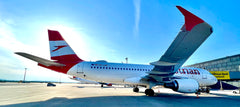CREW
The crew that controls Aircrafttag.com are all active pilots based in Vienna, Austria. Each of us has more than 20 years of experience in aviation, flying the most popular airplanes like A320, B737, B767 and B777.

At the beginning of the pandemic, we had to watch as one airline after another put their fully functional, sometimes still relatively young aircraft into the desert. The majority of these aircraft will never take off again and will be scrapped.
The sensible, ever-increasing focus on sustainability in aviation has further fuelled this process.

That's when we came up with the idea of giving at least some of the aircraft a second life and at the same time making our contribution to sustainability. This also brings us to the why:
WHY
The aircraft skin, which is exposed to minus 40 to plus 40 degrees during a flight, moves against the surrounding air at 1000 kilometers per hour and has also withstood the odd bird attack or lightning strike, is one of the most robust components of an aircraft.

Although we are pilots and professionally burn several tonnes of paraffin every working day, in our private lives we live very sustainably and environmental protection is close to our hearts. So it made sense to combine sustainability and our enthusiasm for aviation and to breathe a second life into the aircraft that were to be scrapped - as already mentioned.
Many weeks of brainstorming, designing, dry business stuff and poring over Excel spreadsheets are behind us. Today we are especially proud of the shape of our aircraft tags. They are modelled on the vertical stabiliser of an aircraft and show all relevant data about the processed airliner.
It is still somehow surreal to know that the aircraft tag dangling from our key ring flew at an altitude of 11,000 meters just a couple of months ago.
